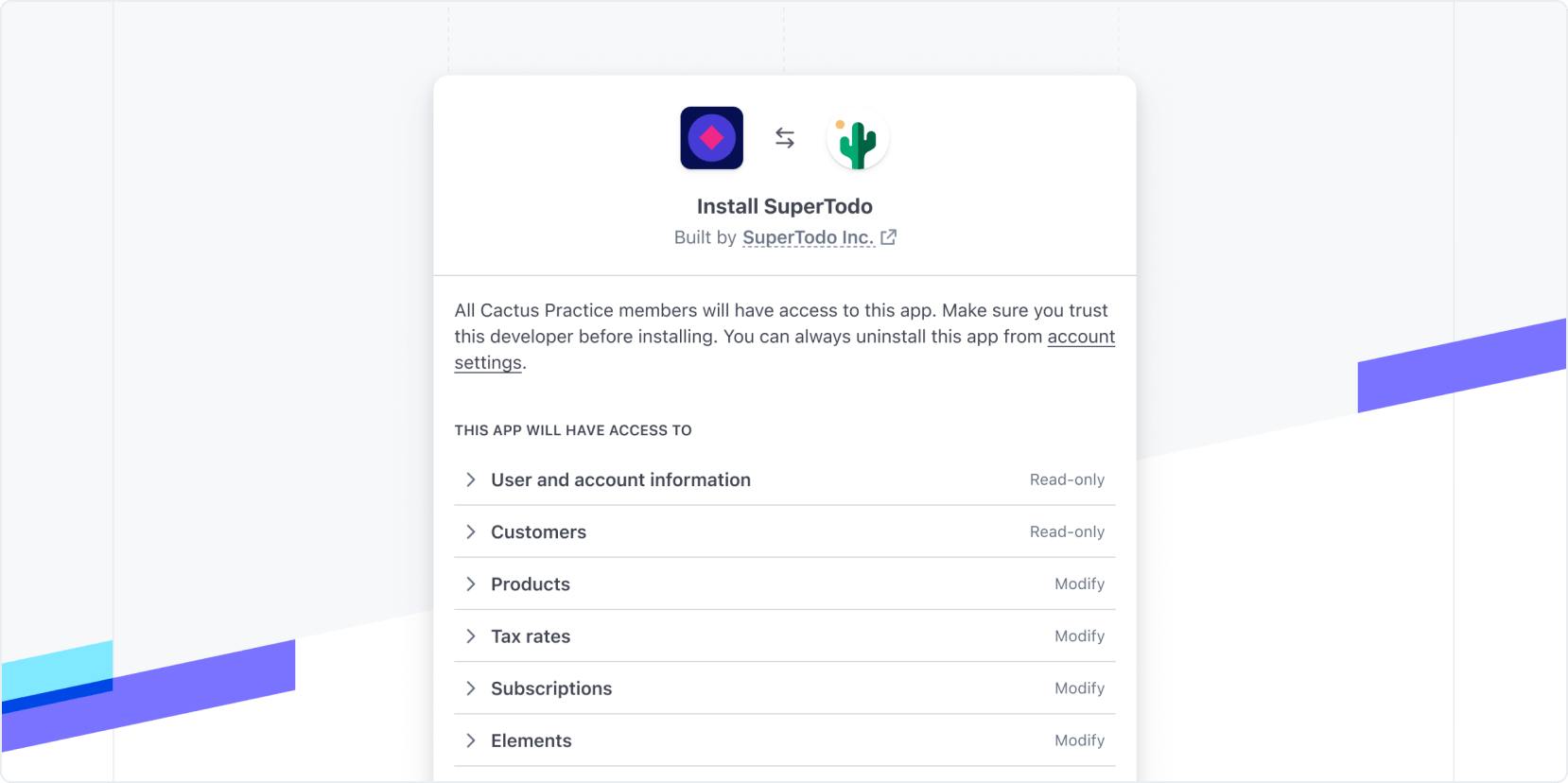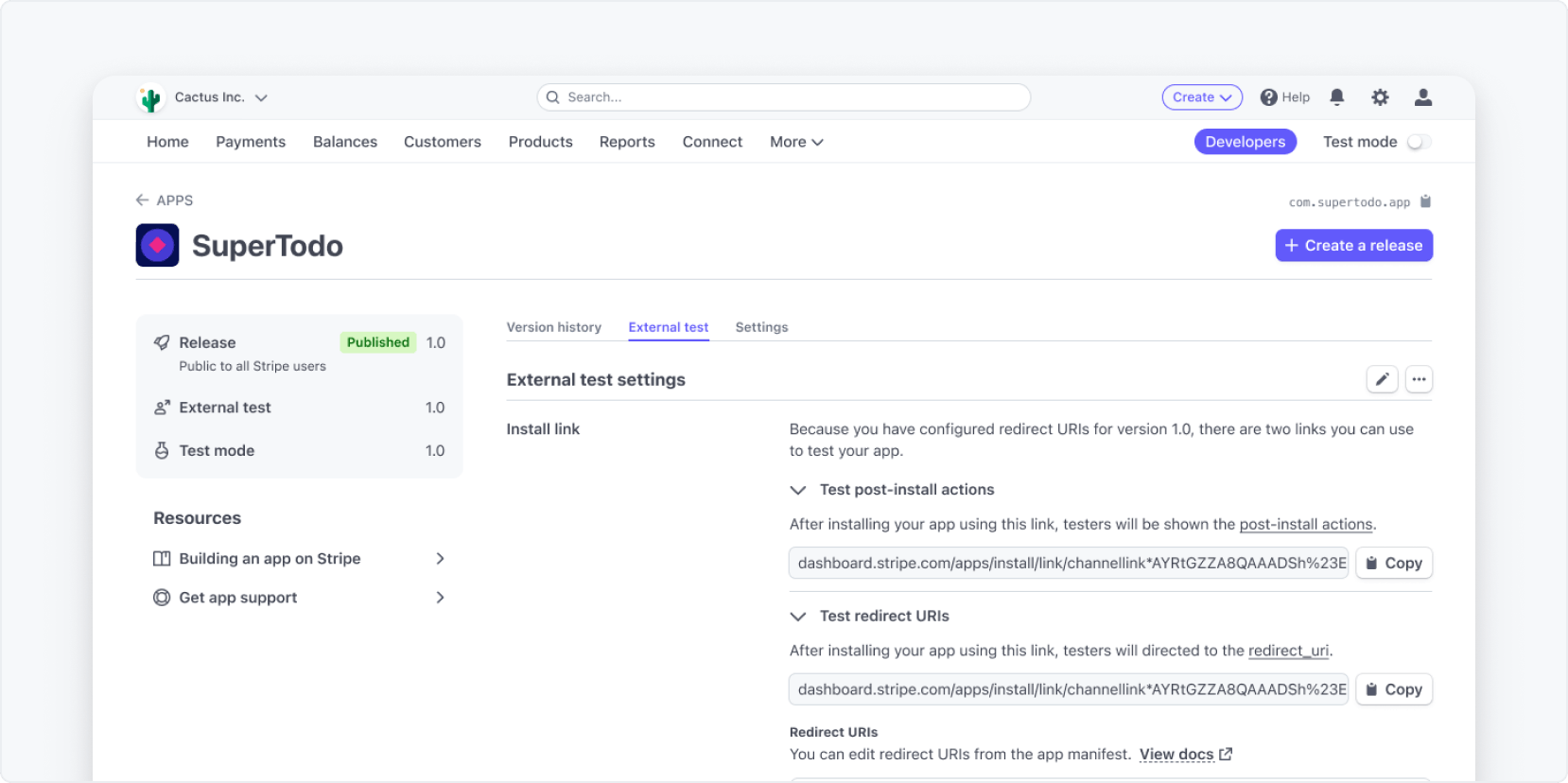Using install linksBeta
Allow users to install your app outside the Stripe App Marketplace.
Install links allow users to install public apps outside of the Stripe App Marketplace. With one integrated flow, you can pass state from your application, complete the installation of the Stripe App, and redirect to your application or site.

The install link page
Overview
With the following steps, a user can install an app using an install link:
- On your site, the user clicks a link that redirects them to Stripe, passing along the
app_.id - On Stripe, the user selects the appropriate account and accepts permissions for installing the app.
- After installation, the user redirects to your site, along with the Stripe account for the given user.
- Your app can now make authenticated account requests.
Create an install link
Set your allowed_ in your app manifest. These are the URLs that users are redirected to after installing your app. You must specify all redirect URLs in your app settings.
After you’ve set allowed_, upload a new version of your app.
{ "id": "com.invoicing.[YOUR_APP]", "version": "1.2.3", "name": "[YOUR APP] Shipment Invoicing", "icon": "./[YOUR_APP]_icon_32.png", "permissions": [], "app_backend": {}, "ui_extension": {}, "allowed_redirect_uris": [ "https://example.com/callback/stripe" ] }
Test your install link
You can use external testing with the following steps to test the install link before submitting it for review:
- Create an external test for your app using the version with
allowed_defined in the app manifest. You can update the testing version to the desired one if a test already exists.redirect_ uris - The External test tab shows a test install link and displays the allowed redirects in a table.
- When you’re ready to publish, make sure that you upload a new version with any testing URIs and values replaced with the values you intend to use in production.

Using an install link
When you’ve finished testing, you can make it available for all users with the following steps:
- Publish a new version of your app that defines
allowed_.redirect_ uris - Click the Settings tab. The install link is shown here, and you can copy it. The link looks like this:
https://marketplace..stripe. com/apps/install/link/{id}?redirect_ uri=https://example. com - Recommended To prevent CSRF attacks, you can add the recommended
stateparameter and pass along a unique token as the value. We’ll include thestateyou provided when redirecting users to your site. Your site can confirm that thestateparameter hasn’t been modified. - After a user clicks the install link, Stripe opens the following page where they can select an account, review app details, and proceed with the installation.

Install link account selection
Redirecting to your site
After the user installs your app, they’re redirected to the redirect_ URL parameter that matches a defined redirect in allowed_ in your app manifest.
Successful installation
For successful installations, the URL includes:
- The
user_value. The ID of the Stripe user that initiated the install.id - The
account_value. The ID of the Stripe account that installed your app.id - The
statevalue, if provided - The
install_value. This a hash of the above values that’s generated using your app’s signing secret.signature - If the app is installed into test mode, a
livemode=falsevalue is appended to the redirect URL.
An example of a live mode redirect:
An example of a test mode redirect:
Installation failure
If the user cancels the installation, they will still be redirected to your site, but the URL includes an error instead:
The user is now connected to your app. Store the stripe_ in your database—this is the user’s Stripe account ID. You’ll use this value to authenticate as the connected account by passing it into requests in the Stripe-Account header.
Verify app installs with install_signature Recommended
It’s important to verify that your app’s user was authorized to install the app for the account provided in the redirect URL. An install_ is included for this reason. This signature is generated from your app’s signing secret and the user_ and account_ that completed the install. The signature also includes the passed state, if provided. The signature can’t be replicated without access to the signing secret, which is only available internally to Stripe and to your app’s backend. Because of this, bad actors can’t replicate the hash if they were to try and spoof the redirect URL. By verifying the app signature, you can trust that the account is associated with your app user.
To verify the signature, follow these steps:
- Create your app’s signing secret if you haven’t done so already.
- Setup an app backend to verify the
install_.signature
Sample backend verifying the install:
The order and naming of the payload fields matter when performing signature verification. The state precedes the user_, which precedes the account_. The resulting object should be { state, user_.
After it’s verified, you can make API calls on behalf of the installed account.
Make authenticated requests
For server-side API calls, you can make requests as connected accounts using the special header Stripe-Account with the Stripe account identifier (it starts with the prefix acct_) of your platform user. Here’s an example that shows how to Create a PaymentIntent with your platform’s API secret key and your user’s Account identifier.
The Stripe-Account header approach is implied in any API request that includes the Stripe account ID in the URL. Here’s an example that shows how to Retrieve an account with your user’s Account identifier in the URL.
See more examples of making an authenticated request here.
Customize links with URL parameters
You can change the behavior of the app installation by including additional URL parameters in the install link.
Supported URL parameters 
| Parameter | Description | |
|---|---|---|
redirect_ | The URL that users are redirected to after installing your app. If provided, this must exactly match one of the comma-separated redirect_ values in your app manifest. To protect yourself from certain man-in-the-middle attacks, the live mode redirect_ must use a secure HTTPS connection. | |
state | Recommended | An arbitrary string value we pass back to you, which is recommended for CSRF protection. |
Prevent CSRF attacks with the state parameter 
To prevent cross-site request forgery (CSRF) attacks, you can use the state parameter. This parameter accepts any string value and returns it unmodified upon redirecting the installer back to your application or platform. To use this parameter, pass a unique and non-guessable value when you initiate an install using an install link. Save the value to use it for verification later.
After the user installs and is redirected back to your application, verify whether the value of the state parameter provided matches the value present in the initial install link. This verification process provides a high-level of confidence to confirm that the stripe_ returned belongs to the user who initiated the install and safeguard against potential forgeries.
Revoking access 
An account. event occurs when a user disconnects your app from their account. You can perform any necessary cleanup on your servers by watching for this event with webhooks.